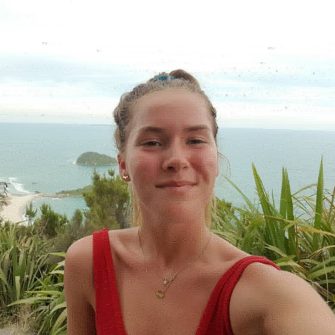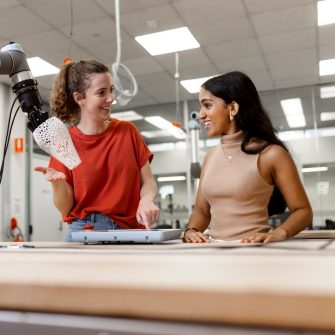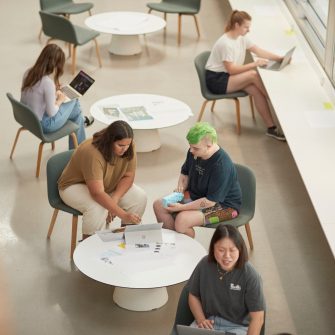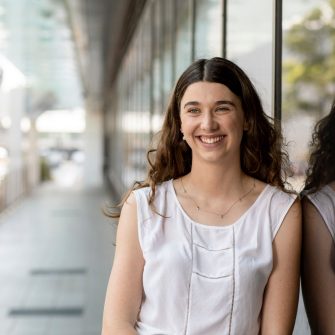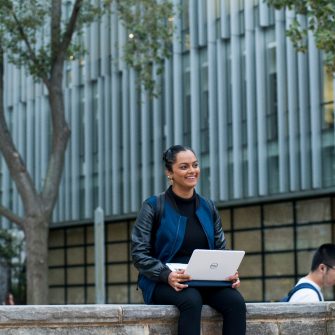Bachelor of Fine Arts / Education (Secondary)
- Commencing Terms
- Term 1 & 3
- Duration
- 4 Year(s)
- Delivery Mode
- Face-to-face (includes blended)
- Campus
-
Kensington
- Codes
- UAC code 422143
- Program code 4068
- CRICOS code 110687D
-
ATAR/2025 lowest selection rank
- 80.0 View all admission criteria
-
2026 Indicative first year full fee
- $8,500*
-
2026 Indicative full fee to complete degree
- $31,000*
-
2026 Indicative first year full fee
- $48,500*
-
2026 Indicative full fee to complete degree
- $212,500*
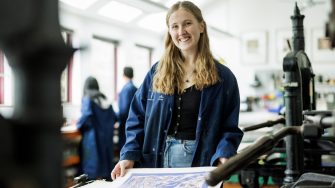
Application closures for 2026
Undergraduate programs for 2026 intakes are closed for New Overseas Student Commencement (NOSC) applications. Applications for postgraduate programs remain open. Find out if this closure applies to you.
- Overview
- Entry requirements
- What will I study?
- Future careers
- How to apply
- Fees & Scholarships
Bachelor of Fine Arts / Education (Secondary) overview
The Bachelor of Fine Arts / Education (Secondary) is a four-year double degree that develops your creative talent while preparing you to teach in a secondary school environment. This unique undergraduate program combines studio-based artistic practice with evidence-based teacher training, giving you the skills to thrive in both the classroom and the creative industries.
You’ll explore a fine arts specialisation – visual arts, music or animation and moving image – guided by leading practitioners in art and design education. In tandem, you’ll learn how to create safe, inclusive and engaging learning environments for secondary students. With a curriculum that includes studio practice, art history, education theory and professional experience placements, you’ll graduate with the confidence to lead creative learning in diverse school settings across NSW and beyond.
This fine arts teaching degree is designed for aspiring educators passionate about teaching visual arts, graphics and multimedia technology or music in high schools across Australia. You’ll graduate with a teaching qualification accredited by the NSW Education Standards Authority (NESA).
Why study fine arts and education at UNSW?
Learn in world-class creative spaces
At UNSW, you’ll study art and design education in purpose-built studios, labs and performance spaces guided by leading practitioners in fine arts and education. You'll have access to industry-standard technologies and facilities that support hands-on creative development across visual arts, music, animation and multimedia.
Combine studio practice with classroom learning
This fine arts teaching degree is uniquely designed to blend artistic exploration with pedagogical training. You’ll develop your own creative identity while learning how to inspire others, integrating your studio practice with coursework in education theory and classroom management.
Gain real teaching experience in NSW schools
Build your confidence and classroom skills through 80 days of supervised professional placement in NSW secondary schools. You’ll work alongside experienced educators to plan lessons, assess student learning and manage classroom dynamics. This first-hand experience will prepare you to thrive as a high school music, art, design or multimedia teacher in Australia.
Want to see more from UNSW Arts, Design & Architecture?
What are the entry requirements for the Bachelor of Fine Arts / Education (Secondary)?
-
- The 2025 Lowest Selection Rank (LSR) is the adjusted rank (ATAR plus adjustment factors) you would have needed to gain entry to this degree in 2025.
- The 2025 A levels score is based on four Advanced Level (A2) subjects. Entry scores are calculated from the best three or four A2 subjects (excluding repeated subjects) using the following values: A*=6, A=5, B=4, C=3, D=2, E=1. At most one Applied A Level subject may be included in the best four subjects used to calculate the aggregate.
- The 2025 IB Diploma is an indication of the IB you would have needed to gain entry to this degree in 2025. It is to be used as a guide only.
- The 2025 Lowest ATAR is the lowest ATAR (before adjustment factors were applied) to which an offer was made. Where <5 is listed, this indicates that less than 5 ATAR-based offers were made and so the score has not been published. N/A indicates no offers were made on the basis of ATAR.
*The Lowest ATAR to which an offer was made, for this program, is based on a UNSW Gateway Early Conditional Offer.
-
At UNSW, we are committed to ensuring prospective students have all the information they need in order to make informed decisions about their study options.
To assist you in gaining a better understanding of how Admissions works at UNSW, we have provided you with a summary of ATAR offers and the student profile.
We hope this information will help you identify the degree that is right for you.
Assumed knowledge
For Bachelor of Education (Secondary) any Band 5 or higher in any 2 units of English
Additional Selection Criteria
Please note that acceptance into the Music specialisation requires you to audition. For more information, visit UNSW Music auditions.
Adjustment Factors
We offer a range of adjustment factor schemes that reward students for academic performance and extra-curricular achievements. These schemes also take into account a range of personal and educational disadvantages that may have affected your studies.
HSC Plus
This scheme rewards students who perform well in Year 12 subjects that are relevant to their preferred UNSW degree. You may be awarded up to five points.
Elite Athletes, Performers and Leaders (EAPL)
This program recognises achievements in the areas of sport, academia, leadership and music at an elite level. You may be eligible for up to five points.
Educational Access Scheme (EAS)
Factors such as illness, financial hardship, language difficulties or attending a particular school can mean you don't always get the best possible marks in Years 11 and 12. If one of these situations applies to you, submit an application for the Educational Access Scheme (EAS) via UAC. Eligible students can receive between 1 and 10 points towards their chosen UNSW degree.
Admission pathways
Your ATAR is not the only measure of your potential to succeed, which is why we offer a range of pathways into university. Explore your options below and get in touch with our Future Student Advisers to discuss your path to UNSW.
Gateway Admission Pathway
This scheme is open to students who attend Gateway schools, live in a low-socioeconomic area based on IRSAD and IEO indexes of SEIFA criteria, or are an Aboriginal and Torres Strait Islander person. It adjusts the ATAR requirements for your preferred UNSW degree and provides early offers and early conditional offers to UNSW.
Entry programs for Australian Aboriginal and Torres Strait Islander people
We offer entry programs for Indigenous Australians, including the Indigenous Preparatory Programs and the Indigenous Admission Scheme (IAS). The entry pathway program you apply for will depend on the degree you want to study.
University Preparation Program
If you want to study at UNSW but faced challenges in year 11 and 12 that make you eligible for the UNSW ACCESS Scheme, but you don't meet the cut-off for degree entry, consider the University Preparation Program.
The University Preparation Program is a one-year pathway to a UNSW degree place. You'll study subjects that allow you to develop your academic skills, including maths skills if needed, so that you can achieve your best results. You also study degree level courses from week one, to give you a realistic introduction to university level study. If you do well in these courses you can earn course credit towards your degree.
English language requirements
You may be asked to provide evidence of your English proficiency to study at UNSW depending on your educational background and citizenship. English language skills are vitally important for coping with lectures, tutorials, assignments and examinations - this is why UNSW requires a minimum English language competency for enrolment.
If you’re completing an Australian Year 12 qualification (e.g. NSW HSC or equivalent), you do not need to provide anything extra to prove your proficiency. Your qualification will be used as evidence of your English proficiency.
If you do need to provide evidence of your English proficiency, this will be indicated in your application. You can prove this by providing evidence that you meet one or more of the following criteria:
- English language tests and university English courses
- Prior study in the medium of English
- Other qualifications
If you need to improve your English skills before you start your degree, UNSW College’s Academic English Programs are for you. The programs are suitable for various English levels and help you prepare for university studies and life in Australia.
For more details, visit the English Language Requirements page.
International direct entry
Information for applicants with CBSE, HKDSE or Singapore A Levels Qualification
Calculating your CBSE Score:
Awarded by CBSE, average percentage marks across English or Hindi, and your best four remaining subjects. Where marks are given as a range, the mid-point for that range is used e.g. 75 to 80 = 77.5.
Calculating your HKDSE Score:
Entry requirements are based on the aggregate of the best 5 achieved category A subjects (category B and C subjects are not considered).
For subjects other than Citizenship and Social Development: level 5**=7 points, level 5*=6 points, level 5=5 points, level 4=4 points, level 3=3 points, level 2=2 points, level 1=1 point, Level U=0 point.
For subject Citizenship and Social Development: Attained=2 points, Unattained=0 point. Citizenship and Social Development will only be counted towards the aggregate if the 2 points awarded for Attained ranks among the student’s best five scoring subjects.
If Mathematics Compulsory Part and Extended Part (Module 1 or 2) are both presented, both scores can be counted.
Calculating your Singapore A Levels:
Due to significant changes to the GCE A-Level Curriculum and University Admissions Score (UAS) calculation effective 2026, UNSW assessment is currently under review.
Note: Entry requirements published on this page are correct as of the day of publication and may change without notice.
We do not accept secondary qualifications from this country. We may accept tertiary study results, please contact us for more information.
Please contact us for direct entry requirements.
Admission pathways
If you do not meet the requirements for direct entry into your chosen degree, you may be eligible for a pathway program with UNSW College. UNSW College provides alternative entry options using university-approved content so that you can start your UNSW journey with confidence.
English language requirements
You may be asked to provide evidence of your English proficiency to study at UNSW depending on whether you are from an English-speaking background or non-English speaking background. English language skills are vitally important for coping with lectures, tutorials, assignments and examinations - this is why UNSW requires a minimum English language competency for enrolment.
If English is not your first language, you’ll need to provide proof of your English proficiency before you can be given an offer to study at UNSW. You can do this by providing evidence that you meet one or more of the following criteria:
- English language tests and university English courses
- Prior study in the medium of English
- Other qualifications
If you need to improve your English skills before you start your degree, UNSW College’s Academic English Programs are for you. The programs are suitable for various English levels and help you prepare for university studies and life in Australia.
For more details, visit the English Language Requirements page.
Check the specific English language requirements for this program
What will I study in the Bachelor of Fine Arts / Education (Secondary)?
The Bachelor of Fine Arts / Education (Secondary) lets you combine your interests for a unique career connected to your talents and passions. In a double degree, you focus on two areas of expertise to graduate with more knowledge, skills and career options.
Despite the name, it's not double the workload. A double degree combines the core courses from two programs. You'll graduate with two bachelor degrees sooner than studying two consecutive degrees.
-
Your education studies at UNSW equip you with the practical skills, theoretical knowledge and professional experience to thrive as a high school teacher. Through a combination of core courses, hands-on placements and teaching specialisations, you’ll learn how to design engaging lessons, support diverse learners and confidently manage the classroom environment.
-
Your education studies at UNSW equip you with the practical skills, theoretical knowledge and professional experience to thrive as a high school teacher. Through a combination of core courses, hands-on placements and teaching specialisations, you’ll learn how to design engaging lessons, support diverse learners and confidently manage the classroom environment.
You’ll understand educational psychology, different social and Indigenous perspectives, inclusive strategies for special education, managing the classroom environment, and responding to gifted and talented students. You’ll also be able to choose an elective course in critical issues, motivation, culture, digital literacy, or communication skills.
-
The first professional experience is a one-day intensive orientation and online activities followed by a four-week supervised work placement. The second placement goes for nine weeks, and you’ll gradually shift towards more autonomy, responsibility, and accountability. Both placements provide you with real-world experience and supportive feedback to guide your future career.
Before starting your professional experiences, you’ll need a Working with Children Check, mandatory anaphylaxis training, and two successfully completed NESA LANTITE (Literacy and Numeracy Test for Initial Teacher Education Students) tests.
-
To teach visual arts, you’ll need to choose specialist courses in visual arts education methods. Similarly, to become a music teacher you’ll choose music education methods courses. However, to teach graphics and multimedia, you’ll study education method courses in visual arts and graphics and multimedia technology.
In each of these specialisations, you’ll design innovative and engaging lesson plans incorporated with effective teaching strategies for diverse learning styles. Find out how to create a safe and supportive classroom environment; and discover innovative resources that assess and improve learning. Through self- and peer evaluation, you’ll understand how to present yourself in a professional manner.
-
-
In the Bachelor of Fine Arts/Education (Secondary), you’ll specialise in one of three creative streams. Each stream combines studio-based learning with art history and theory, helping you develop both your artistic practice and the skills to inspire students through teaching.
-
This ground-breaking specialisation meets industry demand for content developers and creative practitioners. With work experience and intensive skills training in the latest technologies, you’ll graduate with crucial assets for the creative media industry.
Discover what's possible when your imagination comes alive in our custom studios. Innovative and industry-aligned, this specialisation empowers you to thrive as an artist. Learning from accomplished, industry-active media artists, producers, and theorists, you'll work with the latest creative ideas and production methods.
To teach graphics and multimedia, you’ll need to choose visual effects as your first specialisation. For your second specialisation, you can choose animation, moving image, sound, or 3D visualisation. This is a requirement for NESA accreditation.
Animation
Starting with the essential elements of animated movement, you'll incorporate real-world physics into your animated sequences and experiment with 3D as you develop your animation portfolio and showreel. For NESA accreditation to teach visual arts or graphics and multimedia, you can choose to specialise in animation and visual effects.Moving image
Learn how to work with video to produce art, installations, experimental films, and cinema. Starting with digital video cameras, sound recording and editing software, you’ll develop shooting and editing skills as you explore different genres and studio production techniques. For NESA accreditation to teach visual arts or graphics and multimedia, you can choose to specialise in moving image and visual effects.Visual effects
Integrate computer-generated elements with live-action footage as you explore the creative possibilities of visual effects. Working hands-on with digital cameras, greenscreens, and the latest digital software, you'll learn how to create and sequence content to capture audience attention. For NESA accreditation to teach visual arts or graphics and multimedia, you must study visual effects and one other specialisation in animation & moving image.Sound
Get hands-on in our sound studios and acoustic environments to create media artworks using sound-based techniques and processes. Develop skills and knowledge to create compelling soundscapes for screen-based projects as well as sound art for galleries and virtual and public spaces. For NESA accreditation to teach visual arts or graphics and multimedia, you can choose to specialise in sound and visual effects.3D Visualisation
Delve into virtual worlds in our 3D studio and explore how to create virtual environments. Develop the skills and practices required to join a growing digital industry. Through hands-on experience, you'll gain 3D modelling and texturing skills, leading to virtual reality applications and real-time immersive platforms. For NESA accreditation to teach visual arts or graphics and multimedia, you can choose to specialise in 3D visualisation and visual effects. -
Take your love of music to the next level as you reach professional musical standards and create with confidence. Our intellectually and artistically comprehensive classes will prepare you for a long career in music and a lifetime of music-making.
Develop your interests across a diverse range of musical genres under guidance from world-class performers and scholars. The music specialisation allows you to explore and perform classical, experimental, and modern music, music technology, electronic music, and studio recording. No matter what genre draws you in, you'll join a community of supportive and inspiring musicians who value creative, ethical, and cosmopolitan musical practices.
This specialisation includes one-to-one lessons and an array of ensemble classes. Learn professional and technical skills for music performance along with theoretical musicology knowledge. Rehearse and perform in custom-built spaces with extensive support to hone your skills. After your first year, your skills will continue to develop through a flexible pathway, or with a focus on creative practice, music pedagogy or sonic arts.
To become a high school music teacher, you can specialise in any area of this degree – music, creative practice, pedagogy, or sonic arts. In the education component of this double degree, you’ll need to choose the music education method courses offered for NESA accreditation.
Please note that acceptance into this specialisation requires you to audition. For more information, visit UNSW Music auditions.
Ensembles and industry connections
Put your skills into practice and connect with industry professionals through our ensembles:- UNSW Symphony Orchestra
- Collegium Musicum Choir
- a range of jazz ensembles
- New Music Ensemble
- Chinese Music Ensemble
- Balinese Gamelan
- Tango Ensemble
- Bulgarian Voices
- Wind Symphony
You can also choose to build connections and experiences through an industry internship and overseas study.
Creative practice
Devote more of your studies to performance, composition, and creation. Challenge your musical skills to develop and perform a specialised music style that demonstrates your technical and interpretive abilities. Develop your craft by collaborating with others in ensembles and one-to-one lessons. With support from mentors, lecturers, and teachers, you'll produce original performances, compositions, and recordings to showcase at public events.Music pedagogy
Shape your individual style of teaching music to beginners, advanced students, children, and adults. You'll understand how to bring out the best in others by developing an objective approach to your own learning and performance skills. You'll make formal observations of expert teachers at work, get practical experience presenting specialist instrumental and vocal skills, and understand how teaching and learning fit within broader approaches to music education.Sonic arts
Blend ideas with practical skills to explore new sonic technologies and develop your future career in electronic arts. While exploring experimental compositions and recent music production trends, you'll work on projects that build your sound design, sequencing, mixing, editing and post-production skills. You'll combine audio with video and create immersive environments for multi-speaker and surround sound projects. Your learning will take place in our industry-standard recording studios and mixing spaces, and you will learn how to use specialist sonic arts software. -
Immerse yourself in a creative, inclusive, and collaborative community of artists in this studio-based specialisation. Gain artistic skills for your practice through practical projects and experiences using our specialist facilities, workshops, and galleries, ensuring you graduate with professional expertise that helps you stand out.
Develop and combine practical skills across multiple studio areas as you acquire the creative, conceptual, and professional skills for your independent artistic practice. Experimentation is key as you expand your skills and knowledge in contemporary art practice. You’ll focus your studies on at least two studio disciplines, choosing from drawing, painting, photography, printmaking, sculpture and moving image. Gradually hone your skills, refine your practice, create artworks for exhibitions, and build artistic networks as you explore industry pathways.
Throughout your studies, you’ll also learn about the histories and theories that inform contemporary art practice, gaining important analytical, communication and research skills, while critically examining key ideas and debates shaping today’s art and cultural industries.
Choose two specialisations from the options outlined below, with respect to the NESA accreditation requirements as follows:
To teach visual arts upon graduation, you’ll need to choose one two-dimensional specialisation (drawing, painting, photography, or printmaking) and pair it with sculpture, photography or moving image.
You can also choose graphics and multimedia as a second teaching specialisation in the education component of this double degree. If this option appeals to you, you’ll need to specialise in drawing, painting, photography, or printmaking with either animation or moving image.
Drawing
Develop fundamental and exploratory skills in drawing to kick start your contemporary art practice. You’ll work from the human figure, experiment with a range of traditional and contemporary materials and extend your individual practice through rigorous creative approaches.For NESA accreditation to teach visual arts, you’ll need to pair drawing with sculpture, photography or moving image. For accreditation to also teach graphics and multimedia, you’ll need to choose drawing and moving image.
Painting
Engage with painting as a formal, material, and conceptual practice as you develop your individual artistic voice. Challenge conventions as you explore diverse techniques and processes to test ideas and approaches in a critically informed studio environment.For NESA accreditation to teach visual arts, you’ll need to pair painting with sculpture, photography or moving image. For accreditation to also teach graphics and multimedia, you’ll need to choose painting and moving image.
Photography
From analogue darkroom processes to studio lighting and the latest digital image techniques, you’ll develop diverse and transferable skills in the photography studio. Think critically and creatively as you work practically in the studio to explore the material and conceptual possibilities of contemporary photography.For NESA accreditation to teach visual arts, you’ll need to pair photography with sculpture or moving image. For accreditation to also teach graphics and multimedia, you’ll need to choose photography and moving image.
Printmaking
Acquire technical skills in traditional and contemporary print methods across etching, relief printing, screen-printing, and digital processes in the printmaking studio. In this highly collaborative studio, you’ll engage with the latest ideas and debates to generate your own artworks in a contemporary printmaking environment.For NESA accreditation to teach visual arts, you’ll need to pair printmaking with sculpture, photography or moving image. For accreditation to also teach graphics and multimedia, you’ll need to choose printmaking and moving image.
Sculpture
Work sculpturally and spatially to create artworks at scale ready for exhibition contexts. In the sculpture studio, you’ll explore diverse materials and processes from assemblage to mould-making and casting as you consider the tactile, social, and embodied potentials of your practice.For NESA accreditation to teach visual arts, you’ll need to pair sculpture with drawing, painting, photography or moving image. For accreditation to also teach graphics and multimedia, you’ll need to choose printmaking and moving image.
Moving image
Learn how to work with video to produce art, installations, experimental films, and cinema. Starting with digital video cameras, sound recording and editing software, you’ll develop shooting and editing skills as you explore different genres and studio production techniques.For NESA accreditation to teach visual arts and graphics and multimedia, you’ll need to pair moving image with either drawing, painting, photography, or printmaking.
-
Bachelor of Fine Arts / Education (Secondary) program structure
The Bachelor of Fine Arts / Education (Secondary) is comprised of 192 Units of Credit (UOC). It typically takes four years to complete while studying full-time.
This program is structured to meet NSW Education Standards Authority requirements for accreditation in teaching music, visual arts, or graphics and multimedia technology. It consists of 31 individual courses, and you’ll typically complete eight courses a year if you study full-time. (Note that double degrees typically have 32 courses – in this program, your second teaching internship is worth two courses in one.)
To graduate from the Bachelor of Fine Arts / Education (Secondary), students must complete the following:
Bachelor of Fine Arts – 96 UOC
- Fine Arts specialisation – 96 UOC
Bachelor of Education (Secondary) – 96 UOC
- Education core courses – 66 UOC
- Prescribe Education method electives – 24 UOC
- Prescribed Education elective – 6 UOC
-
-
When you enrol in this degree, you’ll need to choose a fine arts specialisation in animation & moving image. Within this specialisation, choose courses on visual effects and either animation, sound, moving image or 3D visualisation. In the education component of this program, you’ll select specialist teaching method courses for graphics and multimedia technology.
You can also become accredited to teach graphics and multimedia in addition to visual arts. In this case, you would have to study animation or moving image with drawing, painting, photography, or printmaking.
-
When you enrol in this degree, you’ll need to choose a fine arts specialisation in music. Within this specialisation, choose courses focused on music, creative practice, pedagogy (i.e., teaching and learning), or sonic arts. In the education component of this program, you’ll choose specialist teaching method courses in music.
-
When you enrol in this degree, you’ll need to choose a fine arts specialisation in visual arts. Within this specialisation, choose courses on two creative practices – one practice in drawing, painting, photography, or printmaking: and the other practice in sculpture, photography, or moving image. In the education component of this program, you’ll select specialist teaching method courses for visual arts.
You can also become accredited to teach graphics and multimedia in addition to visual arts. In this case, you would have to study animation or moving image with drawing, painting, photography, or printmaking.
-
Bachelor of Fine Arts / Education career outcomes
More than just a starting point or a pathway to your first role, the Bachelor of Fine Arts / Education (Secondary) equips you with the professional, creative and interpersonal skills to thrive in careers across education and the arts.
You’ll have the opportunity to pursue a specialisation in visual arts, music or animation and multimedia. As part of your teaching degree, you’ll also have the option to specialise further, taking the required subjects to become a qualified visual arts teacher, music teacher or graphics and multimedia teacher.
Throughout your studies, you'll build deep knowledge in art teacher training, lesson planning, assessment and classroom management. In your final two years, you'll complete up to 80 days of supervised professional placement in at least two NSW schools, developing your teaching skills in real-world environments.
Develop your career opportunities in:
-
- High school visual arts teacher
- High school graphic design teacher
- High school multimedia technology teacher
- High school music teacher
- High school principal
- Corporate trainer
- Curriculum specialist
-
- Animator
- 3D Artist
- Texturing artist
- Concept artist
- Storyboard artist
- Creature effects artist
- Visual effects artist
- Visual effects compositor
- Media arts practitioner
- Digital publishing
- Digital communications specialist
- Art director
- Advertising director
- Film producer
- Television producer
- Post-production designer
- Media strategist
- Sound designer
- Cinematographer
-
- Art critic
- Art director
- Archive manager
- Creative director
- Creative entrepreneur
- Communications officer
- Community engagement officer
- Cultural event manager
- Cultural policy adviser
- Cultural research officer
- Cultural consultant
- Exhibit planner
- Festival curator
- Gallery curator
- Museum curator
- Public event programmer
-
- Audio producer
- Audio engineer
- Broadcaster
- Composer
- Classroom music teacher
- Music journalist
- Performing artist
- Private music teacher
- Session artist
- Songwriter
- Sound designer
- Soundtrack producer
- Tour manager
- Talent manager
- Talent scout
-
- Advertising creative
- Art critic
- Art director
- Artist
- Arts educator
- Arts journalist
- Arts publisher
- Creative director
- Commercial photographer
- Communications officer
- Cultural administration
- Cultural policy consultant
- Event program manager
- Exhibition manager
- Festival curator
- Illustrator
- Installation artist
- Interdisciplinary artist
- Painter
- Performance artist
- Photographer
- Photojournalist
- Printmaker
- Private art teacher
- Sculptor
Accreditation
The Bachelor of Fine Arts / Education (Secondary) is accredited by the NSW Education Standards Authority as an initial teaching qualification for both government and non-government secondary schools throughout Australia and is widely accepted as a teaching qualification internationally.
How to apply for the Bachelor of Fine Arts / Education (Secondary)
Applications for undergraduate study from domestic students (Australian citizens, Australian permanent residents, Australian permanent humanitarian visa holders and New Zealand citizens) are processed by the Universities Admissions Centre (UAC).
Visit the Apply section of the UAC website and you can nominate up to five degrees in order of preference, with the first being your most desired degree and university.
On-time applications for admission usually close at the end of September each year for Term 1 admission. Late applications can be submitted, but a late fee will apply. For study starting in Term 1, the majority of offers are made in December and January. Visit the UAC website for key dates for admission outside of Term 1.
Ready to start your application?
For most international students, applications are submitted via our Apply Online service. We encourage you to submit your completed application as early as possible to ensure it will be processed in time for your preferred term.
Some high-demand programs with limited places, may have an earlier application deadline or may have an earlier commencement date. For details, visit the international admissions information page.
*If you are an international student studying an Australian qualification, go to the Universities Admission Centre (UAC) for application and UAC key dates. Note: If you are under 18 years of age, you need to make special arrangements. For details, visit the under 18 international students page.
Ready to start your application?
Bachelor of Fine Arts / Education (Secondary) fees & scholarships
Commonwealth Supported Place multiple Student Contribution Bands may apply for this double degree. See single degrees for the applicable fee bands.* The student contribution for a Commonwealth Supported Place is an indication only of the amount payable in Year 1 based on a standard full-time load of 48 credit points (1.0 EFTSL). The actual student contribution you will be liable for depends on your individual program of study and the calendar year in which you enrol. Actual fees are calculated upon enrolment. Student contribution amounts are subject to annual review by the University and may increase each year during your studies (subject to caps determined by the Australian Government), effective at the start of each calendar year. The indicative fees listed here are based on an estimated average and are for tuition only other fees and charges are not included.
*Fees are subject to annual review by the University and may increase annually, with the new fees effective from the start of each calendar year. The indicative fees listed here are based on an estimated average and are for tuition only, other fees and charges are not included. The amount you pay will vary depending on the calendar year to enrol, the courses you select and whether your study load is more or less than 1 Equivalent Full Time Student Load (8 courses per year).
Indicative fees are a guide for comparison only based on current conditions and available data. You should not rely on indicative fees. More information on fees can be found at the UNSW fees website.
Indicative fees to complete the program have been calculated based on a percentage increase for every year of the program. Fee increases are assessed annually and may exceed the indicative figures listed here.
Indicative fees to complete the program include tuition plus an estimate of study-related costs of approximately $1,000 per year. To find out more about other costs, visit UNSW International.
Scholarships
At UNSW, we award over $83 million in scholarships each year. We pride ourselves on rewarding excellence and making university accessible to students from all walks of life. Whether you’re a domestic or international student, our range of scholarships, prizes and awards can support your journey.
Progress starts here – at a world-leading university

Top 20 Worldwide
Ranked in the global top 20 for three consecutive years
QS World University Rankings, 2024–2026

Winner of the AFR Most Employable University Award six years in a row
AFR Top100 Future Leaders Awards, 2020–2025

Australia's #1 for Innovation
Highest number of startups and spinouts from university-developed tech
SCOPR report, 2024

